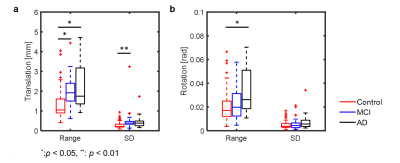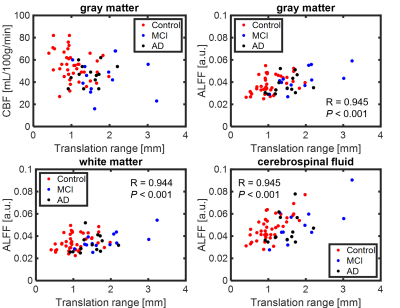Mu-Lan Jen1, Laura B. Eisenmenger2, Sterling C. Johnson3,4, Veena A. Nair2, Vivek Prabhakaran2, and Kevin M. Johnson1,2
1Medical Physics, University of Wisconsin-Madison, Madison, WI, United States, 2Radiology, University of Wisconsin-Madison, Madison, WI, United States, 3Geriatric Research Education and Clinical Center, William S. Middleton Memorial Veterans Hospital, Madison, WI, United States, 4Wisconsin Alzheimer's Disease Research Center, University of Wisconsin-Madison, 53705, WI, United States
1Medical Physics, University of Wisconsin-Madison, Madison, WI, United States, 2Radiology, University of Wisconsin-Madison, Madison, WI, United States, 3Geriatric Research Education and Clinical Center, William S. Middleton Memorial Veterans Hospital, Madison, WI, United States, 4Wisconsin Alzheimer's Disease Research Center, University of Wisconsin-Madison, 53705, WI, United States
This study demonstrates an observed increase in patient motion in Alzheimer’s disease and mild cognitively impair subjects, and a correlation of motion with measures of low frequency oscillations from BOLD MRI.

Figure 1. Box plots of motion estimates from the total recruited subjects. Both range and SD of translation estimates were found to be significantly different between groups (P < 0.01), where the control cohort was found to have smaller translational motion than both MCI and AD (P < 0.05). SD calculated from translation metrics also showed significant differences between groups.
